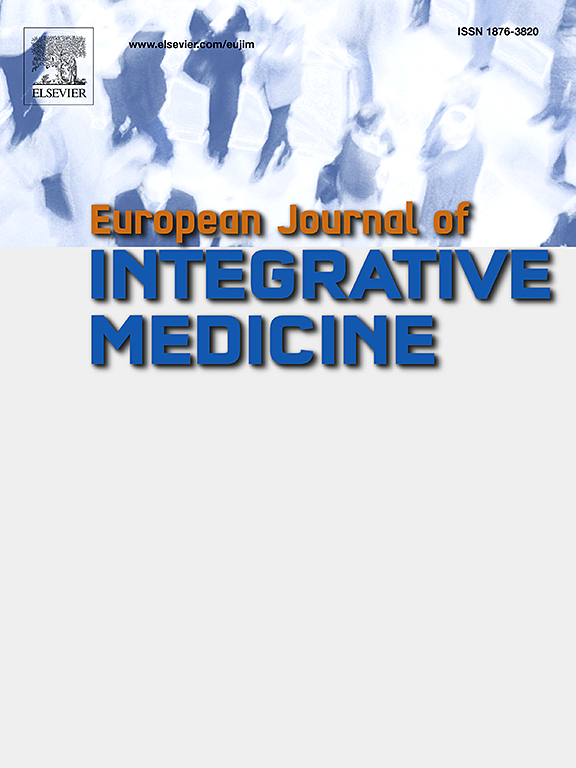Determinants and geographical variations in oral traditional Chinese medicine use among middle-aged and elderly chronic adults in China: A cross-sectional study
IF 1.7
4区 医学
Q3 INTEGRATIVE & COMPLEMENTARY MEDICINE
引用次数: 0
Abstract
Introduction
As the population ages, the numerous middle-aged and older adults with chronic diseases strain healthcare resources and the economy. Traditional Chinese medicine (TCM) has unique benefits in managing these conditions. We aimed to analyze the use and determinants of oral TCM among middle-aged and elderly adults with chronic diseases in China.
Methods
Data from the 2018 China Health and Retirement Longitudinal Study included 13,791 participants aged ≥ 45 years with one of 12 predefined chronic diseases. Provincial units were used to analyze the current use of oral TCM. Logistic regression and machine learning algorithms were employed to identify determinants, with the optimal algorithm selected for variable importance analysis.
Results
In the 2018 wave, the prevalence of current oral TCM use among adults aged ≥ 45 years with chronic diseases in China was 26.84 % (95 % CI: [26.10 % - 27.58 %]), with the highest prevalence in the West (Qinghai) at 46.97 % (95 % CI: [38.46 % - 55.48 %]) and lowest in the East (Zhejiang) at 13.36 % (95 % CI: [10.49 % - 16.23 %]). Northern regions, such as Inner Mongolia (38.13 % (95 % CI: [34.52 % - 41.74 %])), also had high prevalence. Multivariate analysis showed that age, gender, education level, region, number of comorbidities, body pain, and local medical satisfaction were all statistically significant factors. Gradient boosting machine analysis additionally highlighted Communist Party of China membership, religious beliefs, residence, and depressive symptoms as important predictors.
Conclusion
Less than one-third of middle-aged and older adults with chronic diseases utilized oral TCM at the time of the survey, with regional variations: lower in the East, higher in the West, and marginally elevated in the North. Biological, psychological, social, policy, and political-ideological factors were associated with the use of TCM.
中国中老年慢性成人口服中药的决定因素和地理差异:一项横断面研究
随着人口的老龄化,众多的中老年人慢性疾病给医疗资源和经济带来了压力。传统中医(TCM)在治疗这些疾病方面具有独特的优势。我们的目的是分析中国中老年慢性病患者口服中药的使用情况及其影响因素。方法2018年中国健康与退休纵向研究的数据包括13791名年龄≥45岁且患有12种预定义慢性疾病之一的参与者。采用省级单位对中药口服用药现状进行分析。采用逻辑回归和机器学习算法识别决定因素,并选择最优算法进行变量重要性分析。结果在2018年的浪潮中,中国年龄≥45岁的慢性疾病成年人目前口服中药的患病率为26.84% (95% CI:[26.10% ~ 27.58%]),其中西部(青海)的患病率最高,为46.97% (95% CI:[38.46% ~ 55.48%]),东部(浙江)最低,为13.36% (95% CI:[10.49% ~ 16.23%])。北部地区,如内蒙古(38.13% (95% CI:[34.52% ~ 41.74%]))患病率也较高。多因素分析显示,年龄、性别、文化程度、地区、合并症数量、身体疼痛、当地医疗满意度等因素均有统计学意义。梯度增强机器分析还强调了中国共产党党员身份、宗教信仰、居住地和抑郁症状是重要的预测因素。结论调查时,中老年慢性病患者口服中药的比例不到三分之一,且存在地区差异:东部低,西部高,北部略高。生物、心理、社会、政策和政治意识形态因素与中医药的使用有关。
本文章由计算机程序翻译,如有差异,请以英文原文为准。
求助全文
约1分钟内获得全文
求助全文
来源期刊

European Journal of Integrative Medicine
INTEGRATIVE & COMPLEMENTARY MEDICINE-
CiteScore
4.70
自引率
4.00%
发文量
102
审稿时长
33 days
期刊介绍:
The European Journal of Integrative Medicine (EuJIM) considers manuscripts from a wide range of complementary and integrative health care disciplines, with a particular focus on whole systems approaches, public health, self management and traditional medical systems. The journal strives to connect conventional medicine and evidence based complementary medicine. We encourage submissions reporting research with relevance for integrative clinical practice and interprofessional education.
EuJIM aims to be of interest to both conventional and integrative audiences, including healthcare practitioners, researchers, health care organisations, educationalists, and all those who seek objective and critical information on integrative medicine. To achieve this aim EuJIM provides an innovative international and interdisciplinary platform linking researchers and clinicians.
The journal focuses primarily on original research articles including systematic reviews, randomized controlled trials, other clinical studies, qualitative, observational and epidemiological studies. In addition we welcome short reviews, opinion articles and contributions relating to health services and policy, health economics and psychology.
 求助内容:
求助内容: 应助结果提醒方式:
应助结果提醒方式:


